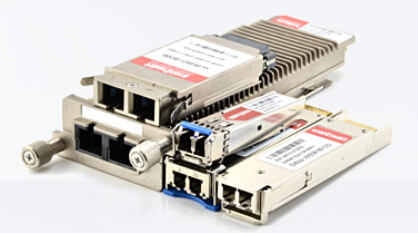There are many different kinds of transceivers available that can be used in telecommunications applications. The different specs and designs are widely used to meet the changing needs of designers. There are some primary kinds of transceivers available for this particular purpose.
SFP
Small form-factor (SFP) transceiver is available for designers to use in various applications. These transceivers come in various transmitter and receiver types. Users can select the right SFP transceiver by reviewing several different categories. Some common categories include:
- 1000BASE-T SFP Copper transceiver module operates on standard Category 5 unshielded twisted-pair copper cabling of link lengths up to 100 m (328 ft).
- 1000BASE-SX SFP operates on legacy 50 μm MMF links up to 550 m and on 62.5 μm Fiber Distributed Data Interface (FDDI)-grade MMF up to 220 m.
- 1000BASE-LX/LH SFP operates on standard SMF optic link lengths up to 10km and up to 550 m on any MMF.
- 1000BASE-EX SFP operates on standard SMF optic link lengths up to 40km.
- 1000BASE-ZX SFP operates on standard SMF optic link lengths up to approximately 70km.
- 1000BASE-BX SFP operates on a single strand of standard SMF lengths up to 10km.
The SFP was one of the most popular types of transceivers until the enhanced version SFP+ was introduced.
SFP Plus (SFP+)
The small form-factor pluggable (SFP+) transceiver is an enhanced version of an SFP and is designed to support data rates up to 10 Gbit/s. Additionally, SFP+ supports 8 Gbit/s fiber channel. SFP+ sockets can be found in Ethernet switches and also network interface cards.
They've the capability to connect to various kinds of optical fiber and are highly flexible. That's why they are so desirable to designers.
SFP+ transceivers are specified by a multi-source agreement (MSA) between competing manufacturers. SFP+ was designed to have greater port density.
XFP
XFP transceivers are designed to be hot-swappable and protocol-independent. These devices can operating at wavelengths of 850nm, 1310nm, and 1550nm. These devices are capable of operating at a single wavelength or through the use of "dense wavelength-division multiplexing techniques."
This particular XFP transceiver was specified by a XFP multi-source agreement Group. Designers prefer using XFP packaging because it has a smaller footprint than other devices. It is smaller than XENPAK and can help the space-conscious designer.
XENPAK
XENPAK became the new standard transceiver with increased support across longer distances and for multiple wavelengths. Unlike GBIC transceivers that sent information across either copper or fiber optic channels, XENPAKs included support for both networks, creating a better, more flexible module. And unlike the bigger GBIC transceivers, XENPAKs were capable of conveying data across short and long distances due to their configuration settings located inside the devices. When utilizing a single-mode configuration, networks create a single ray of light to send data across a long distance, while they use a multimode setup to transmit information across short distances. Both single and multimode fiber optics were utilized by networks, creating the XENPAK device ideal.
X2
X2 Transceiver and XPAK that the older XENPAK modules could no longer keep up with, were made when the 10 Gigabit Ethernet standard took hold. The smaller, more flexible X2 and XPAK standards allowed for even more support for different Ethernet standards and were capable of transmitting data across longer distances.
CFP
The C form-factor pluggable (CFP) is a MSA to produce a common form-factor for the transmission of high-speed digital signals. The c stands for the Latin letter C used to express the number 100 (centum), since the standard was primarily developed for 100 Gigabit Ethernet systems.
There are a variety of transceiver types available, but the most popular ones include: SR, LR, ER, and ZR. SR is 850nm and link lengths up to 300m, LR is 1310nm and link lengths up to 10km. ER is characterized by 1550nm and link lengths up to 40km. ZR can transmit distances up to 80km.
Select the Right Transceiver for Your Design
Always select the right transceiver for your design. If the design is optimized, everything will fall into place for the end user. Try finding the right transceiver for your design. If you would like to find out more about the different transceivers available, you need to ask an expert and study more information about the highly functional devices online. The reliability of your design will improve, and your end-user will reap the benefits of a system that will stand the test of time and also the rigors of a stressful environment. Ask an expert to clarify your choices if transceivers are recommended for your design.


